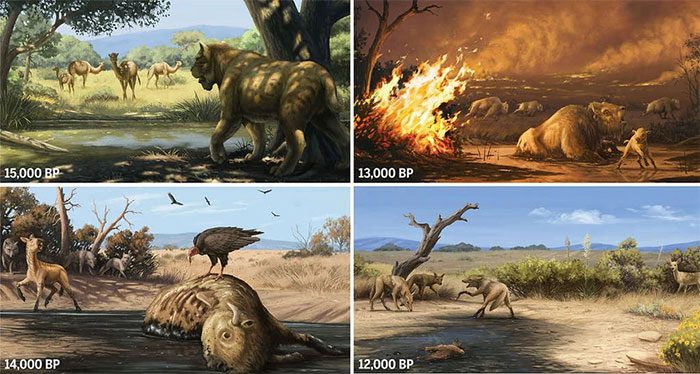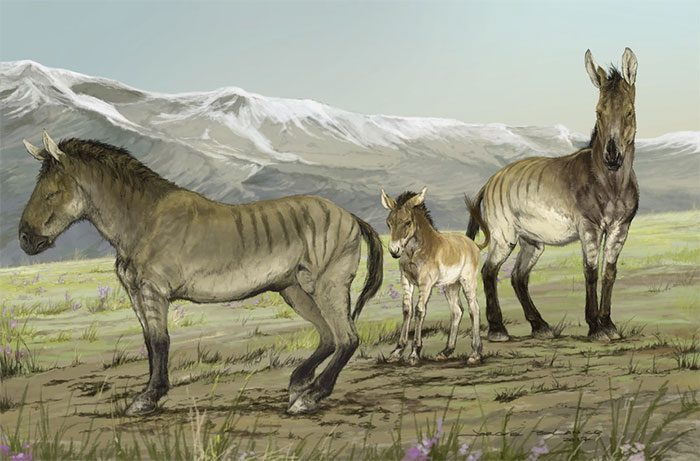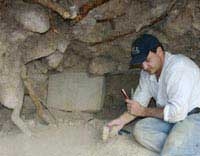Humans and fire have driven prehistoric animals away, just as we see happening in modern times.
If you were to turn back time 140 centuries ago to what is now California, you would encounter some of the iconic creatures of prehistoric times. Giant animals such as saber-toothed cats and dire wolves roamed the land, while humans were just beginning to make their appearance. However, within just 1,000 years, everything changed. All these species disappeared, and the landscape was completely transformed.
Researchers have long been aware of this mass extinction through fossil evidence. However, the exact reasons for its occurrence have not been clearly explained. Now, a new study offers a plausible explanation: This extinction was caused by fire.

The ecological events recorded at Rancho La Brea, California.
A team of researchers examined archaeological and biological evidence in the area, searching for clues about the causes of this extinction. They discovered that around the time of this extinction, large-scale fires ravaged an ecosystem that was already threatened by climate change and human impact.
About 14,000 years ago, temperatures in the Northern Hemisphere began to rise. This coincided with the arrival of humans in North America.
In fact, the situation is strikingly similar to what we are experiencing today.
The authors wrote: “The conditions leading to the state change in Southern California today are repeating across the western United States and in many other ecosystems around the world”. “Understanding the interaction between climate changes and human activities in driving this past extinction event could be beneficial.”

North America was a vast and wild land, home to large mammals such as brown bears, gray wolves, bison, and moose… In fact, tens of thousands of years ago, this area was inhabited by even larger creatures like mammoths and saber-toothed cats, which roamed freely across the continent.
About two-thirds of the large mammal species on Earth, from mammoths to mastodons, went extinct in North America at the end of the last Ice Age. This coincided with climate changes as well as the growth and expansion of the human population. However, while researchers understand what happened, they still do not know exactly how it unfolded.
Much of what we know comes from fossil evidence. But fossil evidence is sparse and imprecise for these time periods. Therefore, researchers are seeking another source of information – and they found it at the La Brea Tar Pits near Los Angeles, California.
The Tar Pits are a unique and effective site for preserving the remains of organisms, often resulting in well-preserved fossils. They contain an almost continuous record of large animals from over 55,000 years ago to the Holocene, 12,000 years ago. Utilizing more than 160 bones from seven different species, researchers examined the timing and causes of the extinction of animals that became trapped in the tar and compared this with carbon records.

By the end of the Pleistocene, although Earth was in an Ice Age, North America was still regarded as a paradise for giant creatures.
The researchers found that the population of mammals in Southern California remained stable from 15,000 to about 13,250 years ago. After that, there was a sudden decline in animal populations, all of which went extinct around 13,000 years ago. This extinction event coincided with environmental changes marked by warming and wildfires.
Carbon dating records indicate that wildfires began to increase around 13,500 years ago, peaking between 13,200 and 12,900 years ago.
Humans arrived on the Pacific coast of the United States between 16,000 and 15,000 years ago and coexisted with large mammals for 2,000 to 3,000 years until these animals became extinct – and very likely, this is not a coincidence, as humans played a significant role in the mass extinction.
Supported by climate change that led to dwindling vegetation, humans may have set some fires themselves to drive animals away, making hunting them easier.

The indiscriminate killing by humans, combined with climate change, led to the disappearance of large mammals in North America, marking the end of the era of giant creatures on the continent.
Michael Waters, one of the study’s authors, stated in a press release: “Wildfires are a way that a small number of people can have a significant impact over a large area”. “This study is relevant to the changes we see in Southern California today. Temperatures are rising, and the area is becoming drier. We are also seeing a significant increase in wildfire incidents.”
The researchers argue that the findings of the study suggest that history may be repeating itself. The challenges that large animals faced during the last Ice Age are similar to what is happening across ecosystems today. Global average temperatures have risen by 1.1 degrees Celsius, combined with significant landscape changes due to human activity.
The study was published in the journal Science.
|
The Significance of the Tar Pits for Paleontology The tar pits are heavy, sticky pools of tar that can trap animals, plants, and other organic materials. When an animal gets stuck in a tar pit, it may attract predators and scavengers, who can also become ensnared. This leads to an accumulation of many different organisms at one site. The unique, sticky nature of tar eliminates oxygen. This anaerobic environment slows down or prevents the decomposition of organic material by bacteria. Many fossilization processes only preserve hard parts like bones, teeth, and shells. However, in the tar pits, the lack of oxygen and the enveloping properties of tar can sometimes lead to the preservation of soft tissues. When an organism is enveloped in tar, it is protected from scavengers that could scatter or consume the remains. The tar also provides a physical barrier shielding the remains from weathering and erosion. Over time, sediment layers can accumulate over the tar, encasing organisms in a stable environment. This additional layer supports preservation by adding pressure and protection. Tar pits can trap organisms for extended periods. This means they can provide a continuous or semi-continuous record of organisms living in an area over time. This can be invaluable for paleontologists seeking to understand the ecosystems and evolutionary processes of past environments. The nature of tar pits makes them relatively easy to detect. Bones and remnants may protrude from the pit partially or be found near the surface. This can make fossil exploration simpler compared to other geological contexts, where deeper digging and careful excavation are required. |





















































